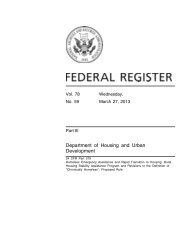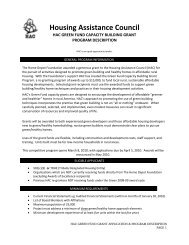Public Relations Guide for Rural Housing Organizations (manual
Public Relations Guide for Rural Housing Organizations (manual
Public Relations Guide for Rural Housing Organizations (manual
Create successful ePaper yourself
Turn your PDF publications into a flip-book with our unique Google optimized e-Paper software.
A 1999 news article notes the importance of public relations in connecting to a particularfunding source just starting to be tapped: the baby boomers.Baby-boomers are replacing their parents as the new generation of donors. . . .They are not very motivated by [Washington] politics. Baby-boomers are moremotivated by local solutions and impacts of an issue. . . . They also want toknow the impact their money had on the cause. . . . Their donation is viewed asan investment – they want a return. Because of the importance of this issue,any communication strategy must satisfy these donor needs. . . A large majorityof baby-boomers are looking <strong>for</strong> organizations to have a clear and effectivecommunications strategy that includes public education and a definite mediapresence. They believe this is central [to] social change. (Giving in the 21 stCentury 1999, 3)Baby-boomers tend to equate public visibility with success, and they fund successful nonprofits.I don’t have time to think about public relations – I’m overwhelmed just trying to do the job athand.Telling the story of your success is as important as pursuing and achieving it. Repeating yoursuccess story will improve your relationship with the public in numerous ways, includingserving more constituents; acquiring new and better board members and volunteers;increasing funding; and being part of community dialogue on social issues (Crocker 2000, 12).Also, consider the morale of your employees; that too will undoubtedly improve as yourorganization’s “stock” in the community rises.Your success is judged in ways even more basic than the amount of funding you receive or thequality of housing you provide; you are also judged in terms of your effectiveness within yourcommunity – how you work in the overall context, which depends on your reaching andinvolving more people in your community in your organization’s goals.A developer’s reputation can have a tremendous impact on the nature and extent ofcommunity opposition to an af<strong>for</strong>dable housing project. A reputation <strong>for</strong> involvement in thecommunity, or <strong>for</strong> developing successful projects in neighboring communities, can reduce thelikelihood of community opposition (<strong>Housing</strong> Assistance Council 1994, 125-26).Each case of citizen opposition to af<strong>for</strong>dable housing development is shaped by the local socialand political environment, the reputation and actions of the developer, and local perceptions ofthe population to be served by the project. <strong>Housing</strong> advocates who feel their af<strong>for</strong>dable or lowincomehousing proposals are likely to encounter local resistance can reduce the likelihood ofNIMBY opposition by initiating a process of assessment and outreach to the community(<strong>Housing</strong> Assistance Council 1994, 125-26). Encourage and make possible your employees’volunteering at other nonprofits in the community or becoming well-in<strong>for</strong>med about relatedissues. Share used, no-longer-needed equipment with other community-based organizations.<strong>Housing</strong> Assistance Council 3









